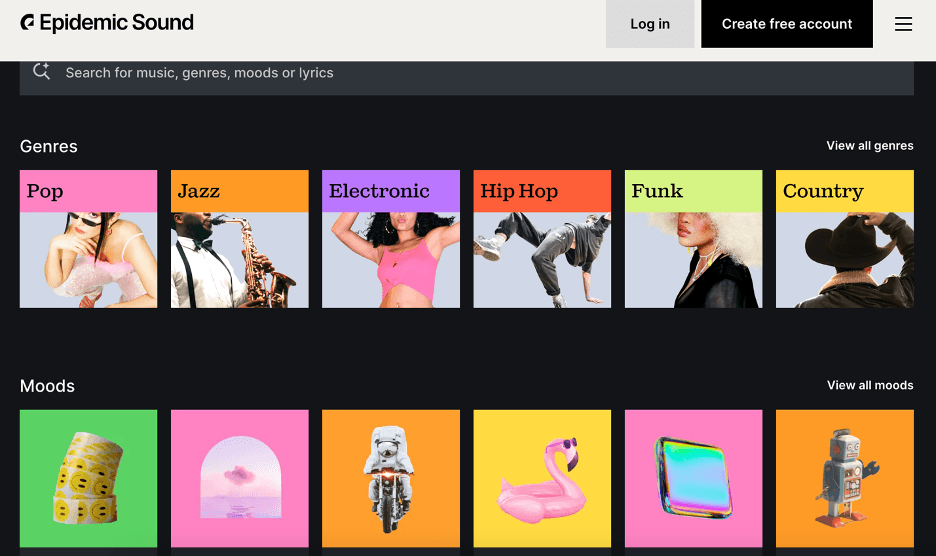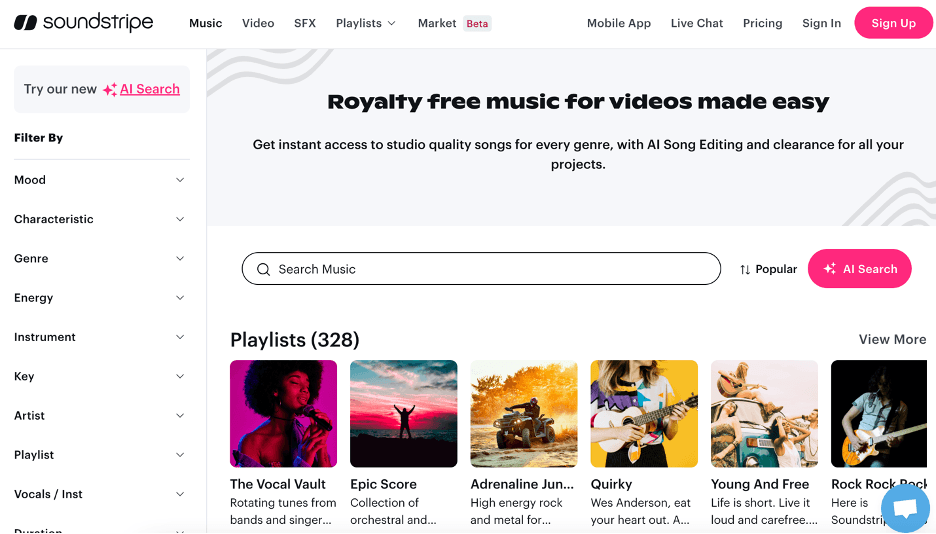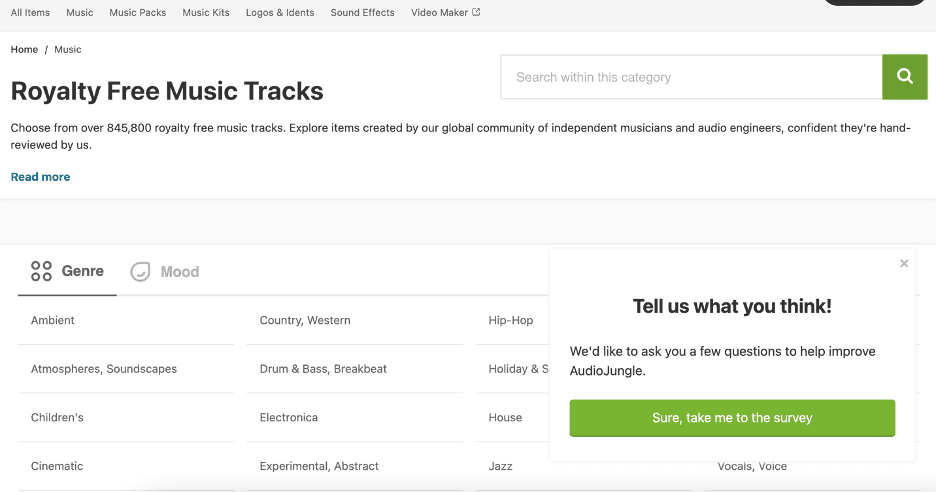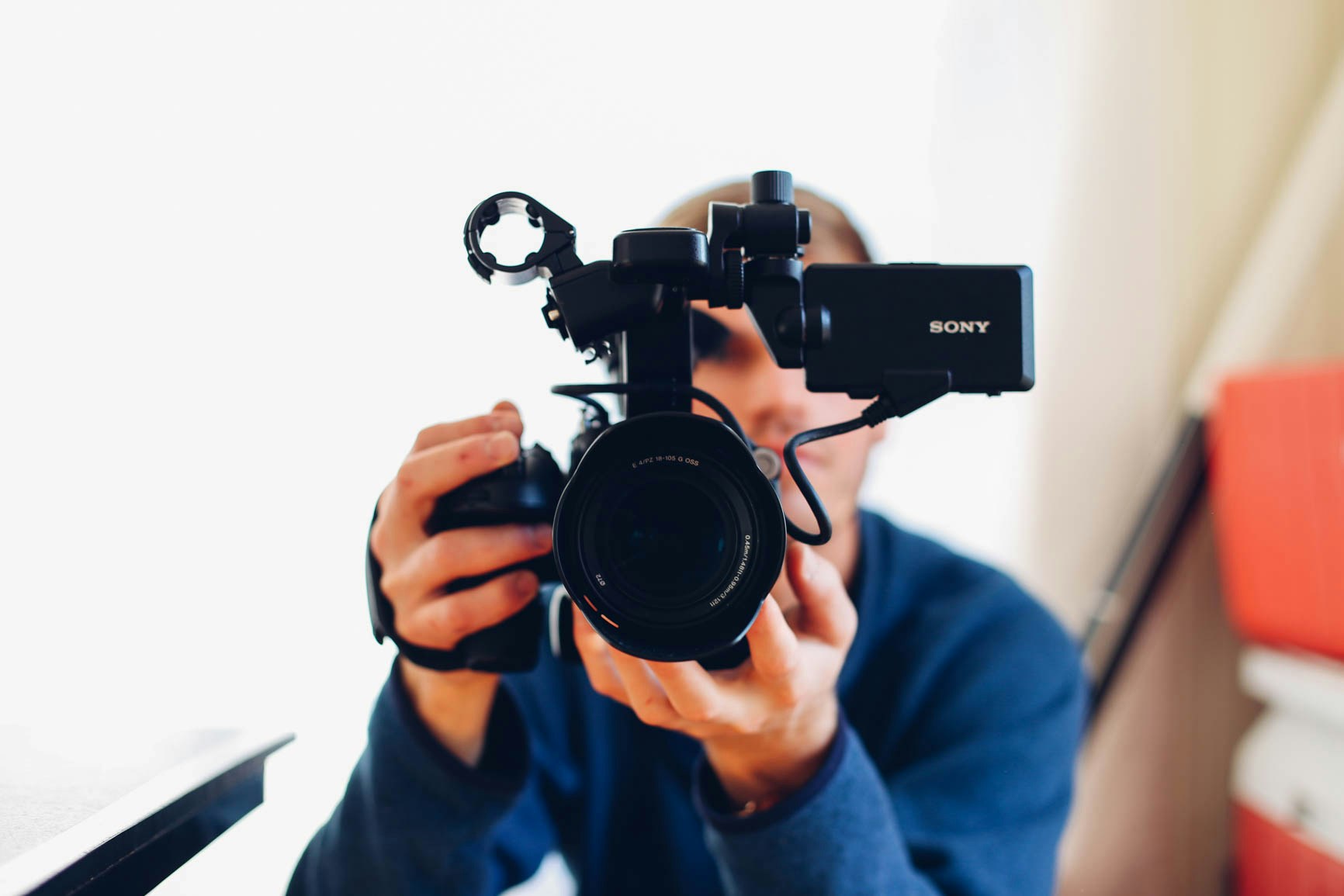Le pouvoir de la musique libre de droits : un guide pour les créateurs et les acheteurs.
Écrit par
Publié le
19 février 2025
Encore en train de défiler ? Va dormir. Tu as un matin tôt. Parfois, on ne peut tout simplement pas poser son téléphone. Le contenu est tellement bon. C'est comme une chose après l'autre - l'algorithme produit des trucs de qualité. Mais qu'est-ce que c'est ? Qu'est-ce qui nous garde à défiler ? Une chose qui se démarque toujours, presque au-dessus de tout le reste, est l'utilisation de la musique. De même qu'une scène clé dans un film ou une série télévisée, l'utilisation de la musique dans contenue est cruciale pour aider à diriger la vidéo dans la bonne direction. Mais qu'est-ce que cette musique ? Je ne peux pas être le seul à devoir trouver un moyen de Shazam une chanson d'une vidéo avec plusieurs appareils qui ne me semble pas familière, seulement pour se retrouver sans résultats. Probablement, mais pas toujours, il pourrait s'agir d'une chanson libre de droits.
Mais qu'est-ce que la musique libre de droits exactement ? La musique libre de droits permet aux créateurs d'utiliser de la musique sans avoir à payer des redevances continues ou des frais de licence. Cependant, ne laissez pas le « gratuit » dans libre de droits vous tromper. Pour utiliser cette musique, une licence initiale ou un frais est acheté ou payé pour acquérir le morceau. Il ne faut pas confondre cela avec la musique sans copyright, qui est gratuite à utiliser car la musique n'est plus sous copyright en raison de la renonciation de leurs droits par le créateur à la chanson ou parce qu'elle est entrée dans le domaine public.

Les créateurs de contenu devraient considérer la musique libre de droits car :
Rentabilité : Des frais abordables pour chaque utilisation.
Conformité légale : Permet à votre contenu d'éviter des problèmes de violation de copyright.
Sélection Diversifiée : Accès à des milliers de morceaux à travers tous les genres, ambiances et styles.
Lorsqu'il s'agit de publier votre contenu sur les réseaux sociaux, Instagram permet aux créateurs d'accéder à une vaste bibliothèque de musique populaire en tant qu'utilisateur normal ou si le compte a été changé en « Compte Créateur ». Les comptes « Instagram Business » sont sévèrement limités dans la musique qu'ils peuvent utiliser, n'ayant accès qu'à une bibliothèque de musique libre de droits. Instagram a une licence générale pour la musique hébergée sur la plateforme – à la fois populaire et libre de droits. On ne peut pas utiliser de musique non licenciée pour promouvoir ou diriger son entreprise ; pourtant, les comptes de créateurs sont autorisés à utiliser une bibliothèque de musique presque illimitée pour améliorer leur contenu. C'est amusant d'une certaine façon parce qu'on pourrait considérer beaucoup de ces comptes de créateurs comme des entreprises en eux-mêmes.
Considérant que les plateformes de médias sociaux se concentrent principalement sur du contenu de courte durée, qu'en est-il des plateformes de vidéos de longue durée comme YouTube ? Bien sûr, YouTube Studio offre aux créateurs une plateforme gratuite pour gérer leurs chaînes, accéder à leurs analyses, éditer leur contenu et fournit un accès à une bibliothèque de musique libre de droits, mais il y a certaines limitations. Beaucoup de bibliothèques externes qui se concentrent principalement sur la musique libre de droits offrent un éventail plus large d'options et sont conviviales, permettant un accès facile à des milliers de morceaux libres de droits pour un prix abordable.
Dans ce guide, nous allons explorer comment les créateurs et les acheteurs peuvent bénéficier des bibliothèques de musique libre de droits.
Pour les créateurs (musiciens)
Pourquoi soumettre aux bibliothèques de musique libre de droits ?
Soumettre votre musique originale aux bibliothèques de musique libre de droits peut offrir une gamme d'avantages pour booster votre carrière en tant que musicien. Certains des avantages incluent :
Exposition : Votre musique est mise en avant sur une plateforme potentiellement accessible par des millions d'acheteurs, tels que des YouTubers, des développeurs de jeux, des cinéastes indépendants, des créateurs de contenu à petite échelle, ou même des marques qui peuvent moins compter sur un budget musical coûteux.
Revenu Passif : Chaque fois que votre chanson est achetée ou licenciée d'une bibliothèque de musique libre de droits, vous gagnez des redevances.
Création de Portfolio : Avoir un vaste catalogue de musique disponible en ligne à la vente ou à la licence peut aider à gagner en crédibilité, à élargir votre public et à rehausser votre CV.
Choisir les bonnes bibliothèques
Sélectionner la bonne bibliothèque qui vous convient le mieux et à votre musique peut être un défi. Certaines choses à prendre en compte lors du choix de la bonne bibliothèque incluent :
Genre : Pensez fortement à quel genre de musique vous créez. Parfois, il est difficile à classifier, mais avoir une compréhension large de ce qu'est votre son - qu'il soit électronique, indie, alternatif ou plus cinématique et audacieux - peut aider énormément.
Qualité : Cherchez des plateformes qui s'alignent avec la qualité de vos productions. Certaines peuvent avoir des standards plus élevés que d'autres, donc si vos enregistrements ne sont pas nécessairement de qualité studio, assurez-vous d'essayer de vous diriger vers une plateforme qui convient le mieux à ce son.
Commission : Faites attention à la structure de commission de la plateforme. Certaines offrent des paiements plus intéressants que d'autres pour l'exclusivité des morceaux sur leurs plateformes. De plus, soyez réaliste avec vous-même à cet égard.

Préparer votre musique
Beaucoup de stress est mis sur la qualité de vos enregistrements. Investir dans un équipement de haute qualité fait une énorme différence. De plus, choisir la bonne plateforme qui s'aligne avec la qualité de votre output peut aider vos chances d'avoir vos morceaux choisis par des acheteurs. Avant de soumettre, assurez-vous que votre musique répond aux normes techniques et créatives requises par les plateformes :
• Qualité Audio : Vos morceaux devraient être de la meilleure qualité possible. Les faire mixer et masteriser professionnellement aide.
• Métadonnées : Les métadonnées sont la façon dont votre musique est classifiée. Assurez-vous de taguer chaque morceau aussi précisément que possible avec des mots-clés appropriés, des descriptions et des genres pour augmenter et améliorer la découvrabilité pour les acheteurs.
• Options de Licence : Certaines bibliothèques de musique libre de droits se concentrent sur l'exclusivité, ce qui signifie que chaque morceau est exclusif à cette plateforme, tandis que d'autres sont plus flexibles et non-exclusives, ce qui vous permet d'héberger votre chanson sur plusieurs plateformes. Lisez attentivement les termes et conditions à cet égard.
Promouvoir votre musique
Soumettre votre musique aux bibliothèques libre de droits n'est que la première étape. Promouvoir votre musique est crucial pour attirer plus d'acheteurs. Si vous faites activement la promotion de vous-même et de votre musique, il est plus probable que les gens recherchent votre travail spécifiquement sur ces plateformes pour l'utiliser dans leurs projets.
• Partagez vos liens sur les réseaux sociaux.
• Soyez actif dans les communautés musicales en ligne et d'autres forums où les créateurs de contenu et d'autres acheteurs recherchent de la musique libre de droits. Cela aide à se faire un nom et améliore votre visibilité.
• Optimisez vos descriptions de morceaux avec des mots-clés et des tags pertinents (voir les métadonnées) pour améliorer la recherche.
Kits AI pour les créateurs
Incorporer les outils puissants de Kits dans votre processus d'enregistrement peut étendre votre capacité à créer une large gamme de musique de haute qualité avec aisance. Utiliser la vaste sélection de voix et d'instruments AI disponibles dans la bibliothèque Kits AI permet aux auteurs-compositeurs et producteurs de créer un catalogue diversifié de musique pour tous les besoins potentiels des acheteurs. Exploiter ces outils fait vraiment la différence dans votre processus créatif et vous permet de créer au-delà des limites possibles que vous pourriez avoir, tout en restant fidèle à votre intégrité artistique.
Pour les acheteurs (créateurs de contenu)
Types de Licences
Il existe différents types d'options de licence disponibles lors de la navigation à travers des bibliothèques de musique libre de droits, et il est important de comprendre comment certaines des plus couramment utilisées diffèrent les unes des autres :
Licence Standard
Les Licences Standard sont les plus couramment proposées par les bibliothèques de musique libre de droits, vous permettant d'utiliser la musique pour une large gamme de projets. Certains de ces projets incluent, mais ne se limitent pas à, des podcasts, des vidéos de courte et longue durée, des présentations, des jeux, et plus encore. Celles-ci sont généralement utilisées pour des projets non commerciaux et commerciaux tels que des présentations, des vidéos YouTube et d'autres contenus en ligne.
Un frais unique est requis pour l'utilisation des morceaux sous cette licence. Une fois que vous avez acheté le morceau, aucun frais supplémentaire ni redevances continues ne sont requis.
Licence Étendue
Les Licences Étendues permettent une utilisation plus large des morceaux que la licence standard. Ces licences sont généralement utilisées pour des projets à grande échelle tels que des publicités TV et radio, des films et des jeux vidéo où la musique est plus au centre et utilisée de façon à générer plus de revenus.
C'est une option plus coûteuse en raison des droits d'utilisation plus larges qu'elle offre, mais avec des projets plus grands vient compréhensiblement plus de coût.
3. Licence de Diffusion
Les licences de diffusion sont spécifiquement conçues pour une utilisation dans les médias de diffusion tels que la télévision, la radio et les plateformes de streaming en ligne à grande échelle. Utilisées typiquement pour des publicités, des émissions de télévision, de la publicité radiophonique et des films diffusés sur une plateforme plus large.
Les licences de diffusion peuvent être un peu plus compliquées. Elles ne sont pas entièrement libres de droits en raison de l'échelle commerciale des projets pour lesquels le morceau est utilisé. Des paiements supplémentaires peuvent être nécessaires selon la fréquence à laquelle la musique est diffusée. Certaines bibliothèques peuvent proposer d'inclure ces frais dans un arrangement de frais forfaitaire.
Comprendre la portée de chaque licence est très important. Certaines licences exigent une stipulation « avec attribution », où l'acheteur doit créditer, ou donner attribution au compositeur ou à la bibliothèque hôte dans leur contenu.
Trouver la bonne musique pour votre projet
Diagnostiquez vos besoins pour votre contenu. Que recherchez-vous ? Quelle est l'étendue du projet ?
Ambiance : Si vous travaillez sur une vidéo de cuisine énergique et entraînante, ou quelque chose de plus motivant, inspirant et sérieux, cherchez en conséquence. Ces mots-clés sont généralement disponibles pour rechercher sur les plateformes et vous mèneront dans la bonne direction.
Genre : Que vous ayez besoin de paysages sonores ambiants et cinématiques ou de chansons rock anthemiques, recherchez dans les bibliothèques par genre et voyez ce que vous pouvez trouver.
Instrumentation : Concentrez-vous sur vos besoins pour des morceaux qui peuvent inclure des sons électroniques synthétiques, des rythmes hip-hop, de la guitare acoustique douce, des arrangements orchestraux, et plus encore.
Budgétisation et Tarification
Les modèles de tarification pour la musique libre de droits peuvent varier de plusieurs manières. Que ce soit un abonnement que vous recherchez pour une utilisation constante sur de nouveaux projets, ou une situation de paiement par morceau, vous devez décider ce qui convient le mieux à votre budget. Des réductions et des packs peuvent être disponibles pour des achats en gros ou des tarifs réduits pour des abonnements à long terme.
Considérations Légales
Comprendre les termes de licence de la musique libre de droits, ou de tout ce qui est lié à la musique, est essentiel pour éviter des problèmes juridiques coûteux et embarrassants à l'avenir. Lisez tout très attentivement et vérifiez pour vous assurer qu'il n'y a pas de restrictions supplémentaires de copyright pour les morceaux que vous utilisez, ou pour ce que vous les utilisez.
Recommandations de Bibliothèques de Musique Libre de Droits
Voici une courte liste de bibliothèques de musique libre de droits que je recommande de consulter :
Epidemic Sound
Offres : Epidemic Sound propose une vaste bibliothèque de musique libre de droits et d'effets sonores pour les créateurs tels que des influenceurs de médias sociaux, des podcasteurs et des cinéastes.
Prix : 10 $ - 17 $/mois. Demandez un devis pour plus de détails sur leur abonnement Entreprise.
Licences : Couvre à la fois des projets personnels et commerciaux avec une couverture mondiale et sans frais supplémentaires.

Soundstripe
Offres : Soundstripe propose un accès illimité à de la musique libre de droits de haute qualité et à des morceaux personnalisables pour des projets de freelance, des vidéos de mariage et du contenu sur les réseaux sociaux.
Prix : 20 $ - 40 $/mois ou 300 $ par trimestre pour leur abonnement Business.
Licences : Fournit une licence libre de droits qui durera toujours, que vous annuliez votre abonnement ou non.

AudioJungle
Offres : AudioJungle abrite près de 2 millions de chansons et de sons sur la plateforme pour tous types d'utilisation.
Prix : Les prix peuvent varier mais peuvent être aussi bas que 1 $.
Licences : Leurs Licences Standard couvrent la majorité de leurs offres, vous permettant de choisir entre des licences Régulières ou Étendues, selon vos objectifs.

Conclusion
Les bibliothèques de musique libre de droits sont une excellente ressource pour tous types de créateurs et d'acheteurs, fournissant un accès à de la musique et des sons de haute qualité pour répondre à chaque besoin. Les problèmes de droits d'auteur ne sont pas à prendre à la légère, donc s'assurer que vous êtes couvert et aborder l'utilisation légale de la musique libre de droits est crucial. Bien sûr, la musique populaire est reconnaissable et peut efficacement élever votre contenu, mais trouver des options similaires et moins chères pour produire le même résultat est tout aussi satisfaisant. Vous pourriez découvrir une nouvelle chanson préférée en cours de route.

